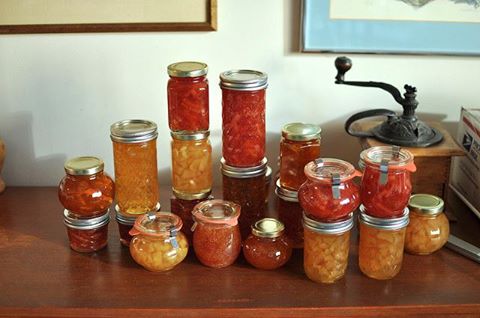For nearly five years I worked at a wonderful food job that kept me mostly behind a desk. I’d spend my days researching ideas, editing recipes, and writing about food—by evening, I was famished. Not just because I’d spent all day thinking about food… It was more than that: I was hungry to cook.
I lived alone, but I had plenty of friends and neighbors to share in my spoils, so I set out to teach myself to make everything I could from scratch. From sourdough breads to spice blends to my own ketchup—I was obsessed. It didn’t take long for this obsession to take a pointedly new direction: canning.
I had eaten homemade canned goods growing up, but had forgotten how intensely satisfying it is. Canning really does capture the best of season so that you can keep a little of it on your shelf.
Before long, I was sweet-talking my way into the back at my market to pick out cases of Concord grapes. I spent hours sorting through seconds at the farmer’s market to find the perfect too-ripe peaches. And I bought a ton of mason jars. I mean, a ton. I ran out of places to store the finished products. I knew I was officially crazy for preserving when my brother visited and went into my entertainment center searching for a DVD and came out with pickles in both hands.
While summer was my main preserving season (it can really be an almost full time job if you’re trying to get some of everything stored away for winter), I loved finding preserving tasks to keep me busy all year long. Enter marmalade: the best way to spend a wintry afternoon, bottling up the best citrus season has to offer.
Quickly ladle marmalade into a hot jar to within 1/4 inch (0.5 cm) of top of jar (headspace). Using nonmetallic utensil, remove air bubbles and adjust headspace, if required, by adding more marmalade. Wipe jar rim removing any food residue. Centre lid on clean jar rim.

Prep your equipment.
The main concern for making any preserved item is having a large pot—large enough to accommodate the fruit when it’s raw, and then large enough that the mixture can cook down efficiently to the proper texture.
It’s wise to have a heat-safe stirring utensil at hand, either a wooden spoon or a Silicone spatula. Just remember that some citrus fruits have a tendency to stain (talkin’ to you, blood oranges), so take that into account before selecting your heirloom wooden spoon.
Other equipment needs include a sharp knife for getting the most out of your citrus.
And if you want to can your marmalade (Do it! Do it! I promise it’s not scary!), you’ll also need basic canning tools: a large boiling water canner with a rack, canning jars, canning tongs (regular tongs will work if you don’t have). You’ll need to sanitize your jars and get everything ready. Check out this canning guide to get started.
This marmalade is my mom’s favorite! There are many orange varieties grown across the world. Have fun creating new flavors and colors of marmalade based on the type of orange you select. A blood orange will deepen the color of the marmalade giving it a beautiful shade of red and will even sweeten its flavor. A Seville orange will gel well with the added sugar for wonderful balance of sweet and tart.
I often use navel oranges because I make marmalade in the winter months when these oranges are plentiful in Michigan. With over 400 orange varieties in the world, I am positive you will find one or more to suite your taste buds. Need some help choosing an orange? The Modern Farmer created a fun guide on some of the more common options. PureWow did a nice job sharing the differing flavors of 10 types of oranges helping you select an orange specific to the flavor you’d like to produce in your marmalade.
How to Make ORANGE MARMALADE RECIPE | Water Bath CANNING |
FAQ
How do you preserve homemade marmalade?
How do you jar marmalade?
How do you store marmalade?
What happens if you boil marmalade too long?
Can Marmalade be frozen?
But you can start testing at 210 by putting a small amount of the marmalade onto a frozen spoon and returning it to the freezer for a minute or two. When you take it out, it should have the consistency of, well, marmalade. Remove your jars, lids, etc. from the canning pot onto a sheet tray lined with dish towels.
How do you make marmalade in a jar?
Using a funnel, hot pack marmalade into hot jars, leaving a 1/4-inch headspace. Remove any air pockets and add additional marmalade if necessary to maintain the 1/4-inch headspace. Wipe each jar rim with a washcloth dipped in vinegar. Place a lid and ring on each jar and hand tighten.
How do you can orange marmalade from scratch?
Orange Marmalade from scratch – including canning instructions and pectin test. Yield: 10 half-pint jars, more or less. Time: 2 – 3 hours (depending on your knife skills and your canning skills) Place several metal spoons in the freezer (at least 3, but more won’t hurt!). Fill your canning pot with water and bring to a boil.
Should you buy marmalade from a store?
Buy from them, if you can. If you have the privilege of hand-picking the citrus you’re using to make marmalade, choose fruit that feels heavy for its size and that seems fairly unmarred (not always possible with homegrown fruit, but small bumps and scrapes can always be cut away during prep).
